

Copyright © 2011-24 Helical Pile World, LLC. All Rights Reserved.
Home | Engineers | Manufacturers | Installation Contractors | News | Technical Advisors | Contact Us






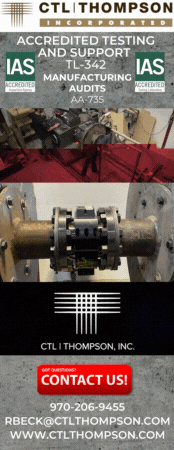
A Tale of Two Projects - Helical Piles vs Drilled Shaft Piles
It was the slower and more complicated of times. It was the faster and easier of times.
In Fort Collins, Colorado, two projects are currently underway. Each is a combination retail/residential multi(3-4) story structure. The projects were started nearly simultaneously and are only about three football fields apart. From one site you can actually see the equipment on the other site. Judging from the size of the footprints at each site, they are similar in size and according to plans submitted and approved by the Fort Collins planning department, the building they have similar uses and load structures. So what makes them different? Well, the foundations for the first project are standard drilled shafts. The second project however, has helical piers as its foundation system.
 The 1st project (let’s call it “The Shaft Project”) is a typical drilled shaft project. The jobsite is characterized by many pieces of equipment (drill rig, concrete pumper, multiple concrete trucks, excavator, dump truck), large numbers of laborers, literally tons of rebar, and even more laborers assembling rebar cages. There are typically a slew of things happening all at once: The drill rig is making 24” & 36” diameter, 20’ deep shafts. Did I mention that the water table is around 10’ deep? Yes, that means these shafts need to be cased. Once the drill rig moves on to the next shaft, an excavator moves in with a dump truck and they remove the drill spoil. The
The 1st project (let’s call it “The Shaft Project”) is a typical drilled shaft project. The jobsite is characterized by many pieces of equipment (drill rig, concrete pumper, multiple concrete trucks, excavator, dump truck), large numbers of laborers, literally tons of rebar, and even more laborers assembling rebar cages. There are typically a slew of things happening all at once: The drill rig is making 24” & 36” diameter, 20’ deep shafts. Did I mention that the water table is around 10’ deep? Yes, that means these shafts need to be cased. Once the drill rig moves on to the next shaft, an excavator moves in with a dump truck and they remove the drill spoil. The  dump truck leaves and the excavator then hoists and lowers the rebar cage into the hole. Because of the water table, the shaft needs to be pumped dry to prepare it for the concrete. Forms are then placed above the shaft with the anchor bolts in position and ready for the concrete. The concrete pumper now rolls into place with its little friend the concrete truck, and the shaft is filled with concrete. Each shaft was taking about one hour to drill another hour for spoil removal and rebar cage placement, another hour for form & anchor bolt placement, another half hour for concrete, oh, and then five days for curing. When I asked the foreman how long it would take until the foundations were complete, he said “We’re hoping for three weeks.”
dump truck leaves and the excavator then hoists and lowers the rebar cage into the hole. Because of the water table, the shaft needs to be pumped dry to prepare it for the concrete. Forms are then placed above the shaft with the anchor bolts in position and ready for the concrete. The concrete pumper now rolls into place with its little friend the concrete truck, and the shaft is filled with concrete. Each shaft was taking about one hour to drill another hour for spoil removal and rebar cage placement, another hour for form & anchor bolt placement, another half hour for concrete, oh, and then five days for curing. When I asked the foreman how long it would take until the foundations were complete, he said “We’re hoping for three weeks.”
The 2nd project (let’s call it “The Already Done Project”) on the other hand is a typical
helical pier project isaracterized by two pieces of equipment (in this case, twin excavators), considerably fewer laborers, and the helical piers awaiting installation. In the 30 minutes that I was on site, five piers were installed. Next, a team of three, using a laser level, torched the tops of the piers off and field welded support braces on. When I asked the site foreman how long it would take to complete the foundations for this project, his response was “We’ll be done in a week.”
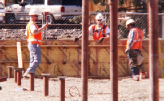 Two projects of similar size, and shape. That is where the similarities end however. Aside from being faster and easier, the helical project was likely cheaper as well (HPW was not able to obtain these figures). Luckily the weather was cooperative and neither project has hampered by inclement weather. Had there been three days of pouring rain/snow/sleet, the helical project wouldn’t have skipped a beat. The drilled shaft project would have slowed dramatically. Stop to consider some intangibles savings that a reduced project time offers.
Two projects of similar size, and shape. That is where the similarities end however. Aside from being faster and easier, the helical project was likely cheaper as well (HPW was not able to obtain these figures). Luckily the weather was cooperative and neither project has hampered by inclement weather. Had there been three days of pouring rain/snow/sleet, the helical project wouldn’t have skipped a beat. The drilled shaft project would have slowed dramatically. Stop to consider some intangibles savings that a reduced project time offers.
1. Interest on the unused real estate
2. Reduced project insurance.
3. Potential incentives for quicker completion.
4. Reduced traffic control if applicable.
5. Improved workplace safety simply by finishing sooner.
HPW would like to extend a special thanks to the helical piering company on Project #2 - Alpine Site Services for allowing me on their jobsite and answering a few questions. If you have any questions for Alpine, contact Mike Oliveira.
A Tale of Two Projects- 1 Month Follow Up
In the original article A Tale of Two Projects, HPW discovered two projects of similar scope and size starting almost simultaneously, and within a stone’s throw of each other. The first project had drilled shafts for its foundation design and the second had Helical Piers.
How are these projects coming along exactly 1 month later?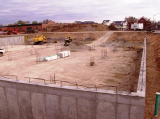
Recall the 1st project. We titled it “The Shaft Project.” This was the project with drilled shafts as its foundation. At the time of our first article, the foundation portion of the project had been going on for about a week and when HPW asked when the whole foundation would be complete the foreman replied “We’re hoping for three weeks.” Well, three weeks ended two weeks ago and here is their progress. As you can see, the foundation is not complete after five weeks. The drilled shafts took so long to complete (four weeks just for the drilled shafts) that the foundation wall are just being erected now. Realistically, the foundation for this project will likely be complete in the sixth week.
Now recall the 2nd project. We titled it “The Already Done Project.” This was the project with Helical Piers  as its foundation. At the time of our first article, the project was in its second day, and when we asked the foreman of this project when the foundation would be complete he replied “We’ll be done in a week.” Well, we at Helical Pier World are happy to report that the foundation for the 2nd project was indeed done in one week. To prove it, take a look at where this project is now. Not only is the foundation long completed, but they are already laying block on the third story!
as its foundation. At the time of our first article, the project was in its second day, and when we asked the foreman of this project when the foundation would be complete he replied “We’ll be done in a week.” Well, we at Helical Pier World are happy to report that the foundation for the 2nd project was indeed done in one week. To prove it, take a look at where this project is now. Not only is the foundation long completed, but they are already laying block on the third story!
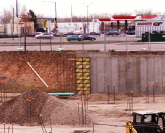 Now for the ironic part of the story. As we previously stated, these two projects are a stones throw away from each other. Below is a picture taken from the 1st project site. Note the 1st project in the foreground with its foundation unfinished. Now look closely, in the distance you can actually see the walls going up at the 2nd project. This is real-time evidence of the speed and efficiency of using Helical Piers paying dividends for the 2nd project.
Now for the ironic part of the story. As we previously stated, these two projects are a stones throw away from each other. Below is a picture taken from the 1st project site. Note the 1st project in the foreground with its foundation unfinished. Now look closely, in the distance you can actually see the walls going up at the 2nd project. This is real-time evidence of the speed and efficiency of using Helical Piers paying dividends for the 2nd project.
HPW would again like to extend a special thanks to the helical piering company on Project #2 - Alpine Site Services for allowing me on their jobsite. If you have any questions for Alpine, contact Mike Oliveira.
A Tale of Two Projects - 3 Month Follow Up
In the original article A Tale of Two Projects, HPW discovered two projects of similar scope and size starting almost simultaneously, and within a stone’s throw of each other. The first project had drilled shafts for its foundation design and the second had Helical Piers.
We first found these two projects in the first week of March. Let’s see how these projects coming along exactly 3 months later?
Recall the 1st project. We titled it “The Shaft Project.” This was the project with drilled shafts as its foundation. The current progress of this project is bordering on laughable. It has been 13 weeks since we published the initial report A Tale of Two Projects and the foundation is still a work incomplete.
Now recall the 2nd project. We titled it “The Already Done Project.” This was the project with Helical Piers as its foundation. As we reported in the first Follow-up article, the foundations for this project were done inde of a week and above grade construction was well underway. Well this juggernaut of a project just marches on, leaving the “Shaft Project” in its wake.
This story and its two follow up pieces are almost too good to be true. It almost seems staged; however, I promise you it is not. These two projects present an experiment that would be difficult to replicate in a controlled setting. These were two projects that began on the same week, just two blocks away from each other. Originally we reported that both projects were of similar size and scope. Well, after a little more research, it turns out the “Already Done Project” is considerably larger as you can probably make out in the photos. We at HPW think that the Shaft Project will eventually complete its foundation in the near future, making yet another follow up article unnecessary. If however, the Shaft Project doesn’t have its foundation completed in 4-6 weeks, HPW will be there to let you know.
HPW would yet again like to extend a special thanks to the helical piering company on Project #2 - Alpine Site Services for allowing me on their jobsite. If you have any questions for Alpine, contact Mike Oliveira.
HPW Archive - 2007


Week 13 – June 6, 2007

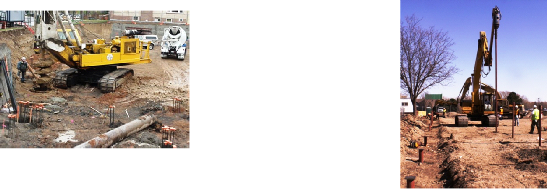
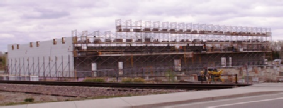
WEEK 7
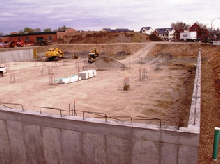
WEEK 1